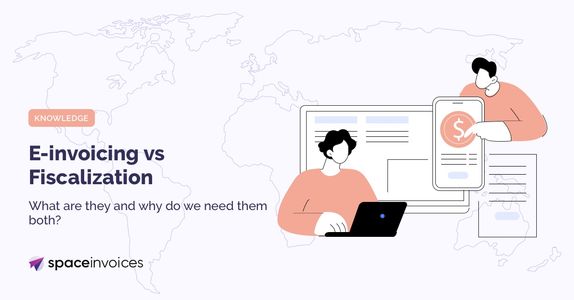E-invoicing vs Fiscalization
Think of fiscalization as a government-controlled mechanism that tracks and documents sales transactions for tax objectives. In other words, it's a vigilant watchdog that ensures no sales slip through the cracks.
Are you ready to demystify two key business concepts—fiscalization and e-invoicing? In this comprehensive guide, we'll discuss their definitions, the connection between them, their distinct characteristics, and their worldwide trends. So, let's dive in!

Unraveling Fiscalization
Think of fiscalization as a government-controlled mechanism that tracks and documents sales transactions for tax objectives. In other words, it's a vigilant watchdog that ensures no sales slip through the cracks, thereby preventing tax evasion and preserving government income.
Fiscalization employs unique tools such as electronic cash registers or fiscal printers that securely log all sales transactions. Each sale is documented through unique, government-verified fiscal receipts, creating an irrefutable record in the seller's system. It's essential for businesses to adhere to their country's specific laws and regulations around fiscalization.
What is E-Invoicing?
E-invoicing, meanwhile, is all about digitizing the invoicing process. It's a digital handshake, facilitating the exchange of electronic invoice, information and documents between a supplier and a buyer in an integrated electronic format.
Why does e-invoicing matter? It minimizes costs, reduces errors, and accelerates payments by doing away with paper invoices and the manual processing of invoice and manual invoice data entry. E-invoicing is the linchpin of modern business processes, catalyzing automation and boosting efficiency in the financial supply chain.

How are Fiscalization and E-Invoicing related?
Though they serve different functional areas, fiscalization and e-invoicing aren't siloed components. They intertwine to ensure transparency, accountability, and efficiency in business transactions.
The common ground between them lies in their shared aim: accurate reporting of sales and business transactions. Fiscalization validates each sale at the point of transaction, while e-invoicing extends the same guarantee to electronic payment of electronic invoices only.
A growing trend is the fusion of e-invoicing and fiscalization through digital fiscalization, which leverages technology—often cloud-based—to store fiscal data securely and generate fiscal reports. This fusion combines fiscalization's accountability and e-invoicing efficiency, paving the way for streamlined business processes and lower costs.
How are Fiscalization and E-Invoicing different?
Despite their overlap, fiscalization and e-invoicing are distinct processes, each with its unique features and functionalities.
E-Invoicing is primarily a B2B (business-to-business) process involving the digital transfer of electronic invoicing information between supplier and the buyer's system. The process is defined by the supplier's and buyer's mutual agreement, and while it is one business that's becoming increasingly regulated, it doesn't inherently require government oversight or intervention.
On the other hand, fiscalization is essentially a B2G process. It demands reporting sales, goods receipts and transactions to governmental bodies for tax purposes and strictly abides by the specific fiscal laws and regulations of each country.

Benefits of Fiscalization and E-Invoicing
Fiscalization ups the ante when it comes to transparency, increased efficiency and accountability in sales transactions, reducing tax evasion and fraud. This process safeguards tax revenues, lower costs for governments and ensures a level playing field for businesses by reducing costs.
E-invoicing, in contrast, enhances operational efficiency, slashes costs linked to paper-based invoicing, and fast-tracks the payment cycle. Plus, it bolsters record-keeping and offers real-time insight into cash flow, sales orders and payment transactions for businesses.

Global Trends
As the world rides the digital transformation wave, fiscalization and e-invoicing trends are rapidly changing. Governments worldwide are embracing digital fiscalization, merging it with e-invoicing, employing digital signatures, and setting up real-time reporting fast payment systems—driven by the need for efficient tax collection and the perks of digitization.
One trend on the rise is real-time or near-real-time reporting of transactions and e-invoices to tax authorities—a trend already adopted by countries like Italy, Spain, and Hungary, with others set to follow.
Major Trends in Fiscalization Globally
Digital Fiscalization: A significant shift is occurring from traditional fiscal devices to cloud-based digital fiscal systems, enabling real-time data transmission to tax authorities.
Real-Time Reporting: Countries such as Spain, Hungary, and Italy have adopted real-time data reporting systems, demanding businesses report sales data and transactions nearly instantaneously.
Integration with E-Invoicing: With more countries embracing electronic invoicing, the intersection of fiscalization and e-invoicing is becoming more pronounced, enabling e-invoices to serve as fiscal documents and simplifying tax reporting.
Major Trends in E-Invoicing Globally
Government Mandates: Countries like Italy, India, and Mexico have made e-invoicing services mandatory for companies and certain businesses. The goal is to combat tax evasion and make companies ramp up efficiency.
Standardization: Efforts are being made to standardize e-invoice formats to enable global adoption. The EU, for example, has rolled out a standard for e-invoicing to streamline digital invoice and invoice processing for cross-border transactions.
Integration with Business Software: E-invoicing solutions are increasingly merging with other business software, like ERP systems, to automate electronic invoicing and boost data accuracy.
Preparing for Developments in Fiscalization and E-Invoicing
Stay Updated: Businesses must remain informed about the fiscal and e-invoicing regulations in the countries they operate in. Consulting with legal experts or tax consultants can be invaluable.
Invest in Tech services: As fiscalization and e-invoicing move towards digitization, businesses need to invest in appropriate tech services or software solutions. This will aid compliance and drive efficiency.
Plan for Change Management: Transitioning to new systems can demand much manual work and considerable change management. Businesses must prepare their teams for this change via training and support.
Automation in Fiscalization and E-Invoicing
Automation can dramatically simplify the adoption of digital fiscalization and e-invoicing. From invoice processing early payment discounts, automated reporting and invoice generation to compliance checks and seamless updates, automation can ensure compliance with minimal effort and maximum efficiency.
A modern and innovative approach to automating both invoicing and fiscalization is to effectively “outsource” these capabilities to an API that does the work for you. By just cutting and pasting a few lines of code into your software platform, you can introduce electronic invoicing and also fiscalization compliance without requiring any software or integration skills. There are multiple solutions on the market that can help. If you only need very basic invoicing support, then Stripe (www.stripe.com) is a market leader in payment solutions that also has some invoicing capabilities. If you want full fiscalization support and e-invoicing in a single API, then Space Invoices is a well-established market leader for you to consider.

Final Thoughts
Global trends in fiscalization and e-invoicing reflect a shift towards digital, real-time, and integrated accounting systems. Both play pivotal roles in enhancing business efficiency and ensuring tax compliance—a testament to the evolution of global business practices.
Businesses must stay informed, invest in technology, and harness automation to align with these changes. As digital trends advance, the convergence of fiscalization manual invoice processing, data, and e-invoicing will only intensify, highlighting their importance in shaping future commerce.
Additional reading:
Start issuing Invoices, free!
Signup and start issuing compliant invoices from your software in minutes.
Or contact us to get a free implementation consultation.
